When we bought our used Southwind, I was the third owner and there wasn’t any maintenance history, so I had no idea where it was regarding preventative maintenance. I performed a very exhaustive pre-purchase inspection which included a look at the front brake pads, but you can’t see the rear pads. The front brake pads looked almost new, so based on this, I assumed the rear pads were also new and the front wheel bearings were probably re-packed. Although I wanted to verify this, I decided to differ this as there were more important issues that needed attention prior to our winter trek to the southern US. In a word – never ASS-U-ME.. Last fall, I replaced all the brake hoses and looked at the front pads. The front pads were in very good shape so I once again decided to differ the pads and front wheel bearings until spring.
Fast forward to today. I’ve put this off for 18 months, the weather is now warm, so its time to re-pack the front bearings and inspect the rear pads. I’m glad I did.
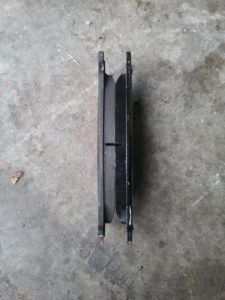
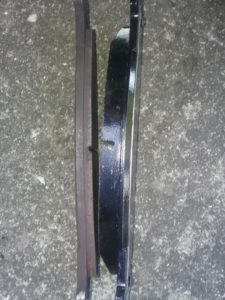
The front pads looked almost new, but the rear pads are worn out. I suspect the previous owner replaced front pads shortly before I bought it. He may not have been aware that unlike automobile brakes, on motorhomes, the rear pads wear out at the same rate or even a little faster than the fronts. Since I didn’t know the age or brand of the front pads, I decided to replace all the pads with Wagner SX777 severe duty pads. This way I’d know exactly what I have and when they were replaced.
AND, since I had everything torn apart, this is a great time to also re-pack the front wheel bearings.
FRONT BEARINGS and SEALS
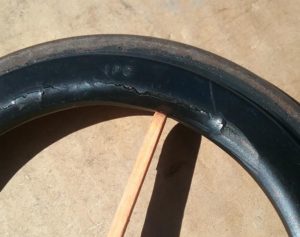
I don’t think the wheel bearings were ever serviced. When I removed them, there was a somewhat minimal grease, and the nut seemed like it was tightened to the factory spec. The bearings and races look OK with no wear or pitting. When I examined the seals, the lip on the seal was brittle and cracking. This inspection and servicing was very timely as the seals were bad and ready to start leaking grease.
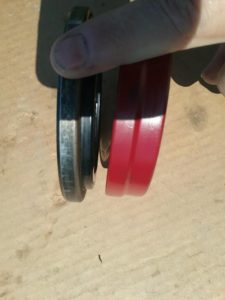
I ordered new seals and brake pads from Rock Auto. I was initially concerned that the new seal was significantly different than the original. Its about 1/4 inch thicker, and protrudes out the back of the wheel a little farther. I measured the seal to verify it had clearance when installed. It appears to be OK.
PART NUMBERS
My chassis is a 1999 F53, 20,500lb chassis. The bearing numbers I got off the bearings. The seals and pads numbers I got from RockAuto
- Front bearing (outside) < Timkin 25880
- Front bearing (inside) > Timkin 45284
- Front wheel seal > National 2674
- Brake pads (front and rear) > Wagner SX777
REMOVE
- Remove wheel,
- Now’s a good time to pressure wash brake hub, calipers, etc..
- Remove brake caliper and mount. DO NOT allow the caliper to hang by the hose. I use a coat hanger to suspend the caliper from the shock tower.
- Remove the 4 bolts from the center cover and remove the cover
- Remove the cotter pin.
- Remove the hub nut, it should be just a tiny bit snug
- Remove the keeper washer and the outer bearing will pop out
- Pull the hub assembly off the spindle. WARNING – Its heavy
- Remove the rear seal and bearing from the hub
Before cleaning the bearings, inspect them for tiny shiny metal flakes embedded in the grease. These are signs of a damaged bearing.
I wiped off excess grease with paper towels, then cleaned the bearings, races, hub, etc with solvent, After they were clean I sprayed them with brake clean to remove any residue. Let them dry thoroughly, then inspect them. Wipe the spindle to remove old grease and dirt. I used a small wire brush to clean the anti skid sensor, spraying it with brake clean.
INSTALL BEARINGS and HUB (FRONT WHEELS)
- Pack the bearings with a high temp synthetic bearings grease.Wipe grease on the spindle and the races.
- Install the rear bearing and a new rear seal in the hub
- Slide the hub onto the spindle, install front bearing and the keeper washer.
- Hand tighten the spindle nut
- IMPORTANT – TIGHTEN SEQUENCE
- while spinning the hub, torque the nut to 30 ft lbs
- loosen the nut 2 turns
- while spinning the hub, torque the nut to 15 ft lbs
- loosen the nut 1/2 turn
- while spinning torque to 17 in lbs NOTE – this is INCH POUNDS, NOT foot pounds
- Tighten to line up next cotter pin hole
- Install cotter pin
- Install hub cover
INSTALL BRAKE PADS
The front and rear pads are identical. The new pads come with new stainless guides and slide grease.
When removing the calipers, don’t allow them to hang by the hoses, this will destroy the hoses internally. I used a 5 gallon bucket flipped upside down to rest the calipers on when working on the pads.
NOTE – The two stainless guides are different. Look carefully at the center tab on the guide. One has a tab that sticks out and the other doesn’t.
- Verify the caliper pistons are compressed. (fluid may overfill the brake reservoir when you compress the caliper pistons)
- Clean the caliper slides and caliper bolts
- Install the caliper mount. Torque bolts to 250 ft lbs (These were removed from the front to re-pack the bearings)
- Install new brake pad guide hardware and brake pads. There are two stainless guides for each caliper, they are different. (see photo below). You may need to lift the stainless tabs a little to get the new pads to slide in under the stainless tabs.
- Install the caliper, coat the caliper bolts with lubricant. torque to 45 ft lbs.
CALIPER INSTALL NOTES
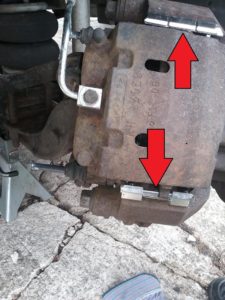 Look carefully at how the caliper and the stainless guides are mounted. The bottom of the caliper pulls straight out, but the top of the caliper has a small paw that sticks up under the bracket (and stainless guide). Pull the bottom of the caliper out about an inch, the caliper can now drop down so the paw on the end of the caliper can slide down and clear the mount.
Look carefully at how the caliper and the stainless guides are mounted. The bottom of the caliper pulls straight out, but the top of the caliper has a small paw that sticks up under the bracket (and stainless guide). Pull the bottom of the caliper out about an inch, the caliper can now drop down so the paw on the end of the caliper can slide down and clear the mount.
When you install the caliper, you need to slide the top of the caliper up so the paw is under/behind the mount and stainless slide. the bottom then pushes in.
INSTALL WHEELS
Ford issued a TSB for 1999, 2000 F53 for a vibration that occurs between 45 and 65 mph. Mine definitely had this vibration. It was significantly reduced when I used the centering sleeves to install the wheels. If the TSB applies to you, read the article about how to use the centering sleeves. The fronts are a little easier to install than the rear dullies.
- I have the early model F53 where the lug holes are slightly oversize and the wheels will not center on the hub. There is a TSB for this that calls for using sleeves on the lugs when installing the wheels. The sleeves will help center the wheel, then are removed.
- Use the centering sleeves when installing the wheel.
- Torque the wheel lugs to 150 ft lbs.
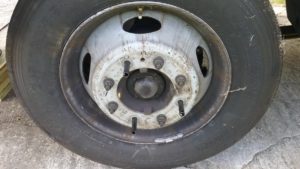
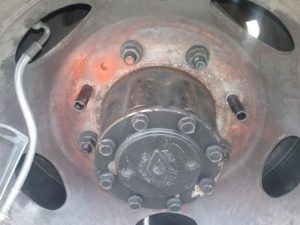
BEDDING THE BRAKES
The friction quality of new pads and rotors isn’t very good. To maximize the braking ability, the new pads need to be “bedded in” This process incrementally heats the brakes and causes the material and adhesives to cure at high temperatures, thus improving the braking qualities. Here’s a procedure I use:
- Perform 6 – 10 medium stops from 45 – 50mph. Slightly more aggressive than normal braking. You don’t need to come to a complete stop for each pass. This brings the brake rotors up to temperature so they’re not exposed to sudden thermal shock. You’ll smell the brakes.
- Make 10-20 aggressive stops from 45 -50mph down to 5mph. For this set of semi-stops, you want to be firm and aggressive, but not to the point where ABS activates and the wheels lock up. It’s important to note that you don’t come to a complete stop but rather a semi-stop (~15mph). Accelerate back up to 60mph as soon as you slowed down to your semi-stop.
- The brake pads and brake rotors are extremely hot at this point and sitting stopped will imprint the pad material onto the surface unevenly. This can cause vibration and uneven braking.
- You’ll notice that your brakes will start fading, and sometimes smoke, after the 6th or 7th pass. This fade will stabilize and will gradually decline once your brakes have cooled down to normal operating temperatures. Drive carefully as your brakes may feel softer for the next few minutes.
- Try not to come to a complete stop during the process. When finished, find a stretch of road where you can drive for 10 – 20 minutes without using the brakes to allow the brakes to cool.
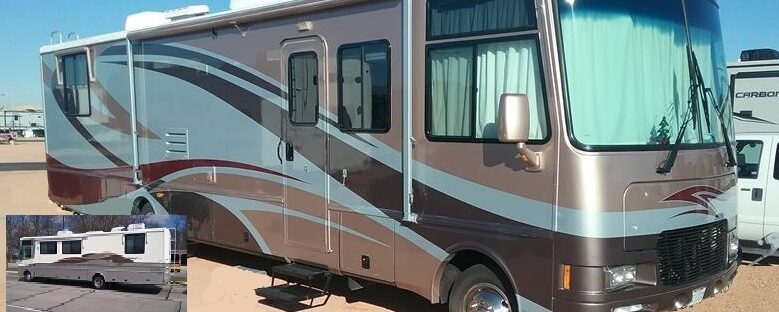
Thanks, great articles here. Getting ready to do the front bearing service and brake inspection on out ’09 F53 chassis.
where to get centering sleeves for wheels
look in this article. There is a link to an Amazon seller.
https://www.1999southwind.com/funny-vibration-around-50-mph-wheel-centering-on-f53/
Pingback: Upgrade report – A little more power and better fuel economy – 1999 Southwind 35S
Great article, now I have confidence to do mine, gonna tackle it as I have some grease appearing on my wheel simulators after going about 25 miles yesterday, sure that the wheel bearings haven’t been serviced since it was new, 1997 Georgie Boy, new to us last year. It sets on a ford F53 chassis of 1996 vintage.
Thanks for the info, I have a 2006 fiesta fleetwood. I am replacing both front rotors because they appear to be warped.. The brake pads rub every half turn causing a woof, woof sound when driving. I’m replacing the rotors, bearings, races, seal and brakes… Hopefully this clears the noise.
I am in need of spec torques, I got the ones for the caliper and caliper mount, does anyone have the spec torque for the 10 bolt that couples the hub and rotor.
This is all I need to put it all all back together again when the parts come in.
Thank you for sharing all this information and specs, as it’s hard to come by all?this info and know how.
I appreciate it very much.
Raul
Hello, I really appreciate the write up on performing a brake job.
I was wondering why there is no write up to cover the disassembly of the rear hub, removal of the bearings, and re-grease.
Any info to perform that part would be very appreciated.
Thank You
Doug
On my differential, the rear bears are lubed by the differential fluid, so there is no reason to dis assemble them.
That makes sense. My F-53 has a Dana S110 rear differential. I located the manual online which indicates that the bearings are oiled through a service hole on the hub or from the oil supply in the differential. Thanks for the reply, I feel more confident knowing how to service the differential.
Doug
Are you still available to talk? I’m wanting to buy a hub, I have a spun bearing on the outer. I was wondering if you may have a spare hub you would like to sell in any condition?
No, no spare hub. I wonder if a hub from a F350 or 450 would work?